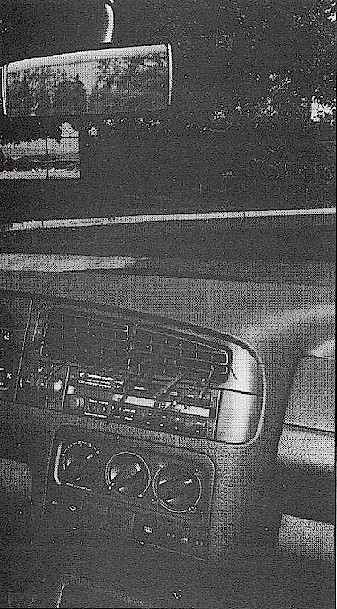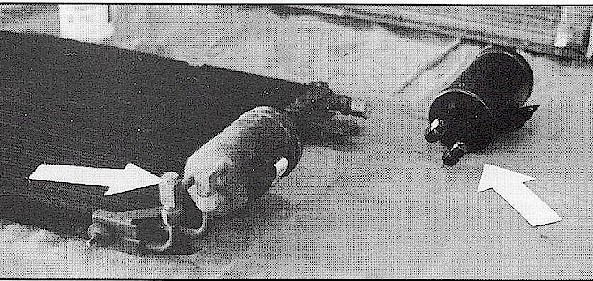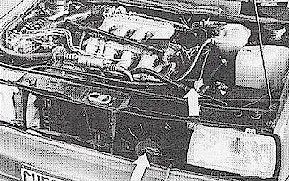
RETROFITTING IS AN ENVIRONMENTAL UPGRADE
The automobile industry, in conjunction with the Society of Automotive Engineers (SAE), has established retrofitting procedures for upgrading your existing CFC R-12 auto air conditioner to HFC R-134a, a non ozone depleting refrigerant. R-134a is currently being installed in most new production vehicles. This compound is the only refrigerant acceptable by the EPA.
UPGRADING YOUR VOLKSWAGEN AIR CONDITIONER
Volkswagen air conditioning system consists of five major components, the compressor, condenser, orifice expansion valve, evaporator, and accumulator-dehydrator. This is how it works. The compressor brings in the refrigerant gas from the evaporator and compresses it under high-pressure low circulation through the system. The condenser removes heat from the refrigerant and condenses the gas to a

The old style receiver drier (still attached to standard condenser) and -the new R-134a receiver drier. The different style of fittings allows it to be used
| liquid. The orifice expansion valve, or tube,
regulates the flow of high-pressure liquid refrigerant to the evaporator there by lowering
the pressure. The evaporator is then used to cool, dry and clean the air that enters the
passenger compartment. Lastly, the accumulator-dehydrator separates liquid refrigerant
from the gas stale before it enters the compressor and removes moisture from the system. The introduction of KFC R-134a refrigerant has solved the environmental problems of CFC R-12, yet there are new issues, which have to be considered. Initial testing of HFC R-134a has shown higher operating pressures than that of CFC R-12. The new gas R-134a is less active than Freon R-12. This results in [he gas changing t o a liquid at a slower rate than R-12. When retrofitting an existing R-12 system, we are now confronted with differences, which have to be addressed. VOLKSWAGEN AIR CONDITIONING SYSTEMS From the later 1960s through the 198Os, VW air conditioners were notoriously poor performing systems. This poses numerous problems for retrofit because of the basic key components (condensers and evaporators) have poor heal dissipation characteristics. This situation is enhanced with the use of R-134a which is not as active a gas as R-12. On a VW the condensing is the primary concern when performing the R-134a upgrade. The new design parallel flow condenser must be used along with high
An early '90s Jetta with the R-134a conversion, including receiver drier and auxiliary condenser fan (arrows). |
capacity (airflow) cooling fan to ensure compressor head pressures are
kept within guidelines prescribed for R-134a. Refrigerant psi evaporator expansion valves
must also be replaced with larger orifice tubes to increase flow rate. This ensures
increased amounts of refrigerant to increase evaporator, performance. The a/c hoses may also need to be replaced with a new Barrier type. The new R-134a gas will permeate through older a/c hoses. When upgrading your Volkswagen's system, check the hoses if they are labeled Barrier, only Barrier type hoses will work with the R-134a systems. Earlier model VWs did not have Barrier type hoses. Some air conditioning systems after they are upgraded may vary 4-6 degrees higher vent outlet temperatures. Therefore it may be necessary to dial in heat settings and expansion valve orifice sizes. CONCLUSION What does all this mean to the Volkswagen owner? If you plan on keeping your vehicle for a few years, it may be necessary to upgrade your air conditioning system. If your system is currently nut operating properly, you are a prime candidate to upgrade. The cost of R-12 is now higher than R-134a and soon will be unavailable to recharge your system after it is repaired. When the existing supply of R-12 is exhausted the demand for upgrading will increase as will the price. The automotive industry predicts during the hot summer months there will be waiting periods of 30 days or more to get your air conditioner repaired or retrofitted. Upgrading your car's air conditioning will also increase its resale value. In these changing times of heightened environmental consciousness, automobile air conditioning must become environment tall y friendly to improve our global ecology. One company that for 36 years has been providing air conditioning services and equipment for all automobiles, including Volkswagens. I.C.E. Inc. 3275 Market Street. Dept. HVWs, San Diego. CA 92102 (619) 338-9051. They will be providing both information and data pertinent the environmentally safe retrofitting of air conditioners as well as upgrade kits for all makes and models of cars, including all VWs.
|
